Muscle Anatomy, Function, and Force Mechanics in Kinesiology
1/69
There's no tags or description
Looks like no tags are added yet.
Name | Mastery | Learn | Test | Matching | Spaced |
|---|
No study sessions yet.
70 Terms
What is the primary role of muscles in the body?
Muscles control the balance between posture and movement, enabling stable posture and movement through competing forces.
Why is understanding muscles important for clinical practice?
It helps form clinical hypotheses about muscular impairments and adaptations that affect functional activities, leading to appropriate interventions.
What are the two primary classifications of muscle shapes?
Fusiform and Pennate.
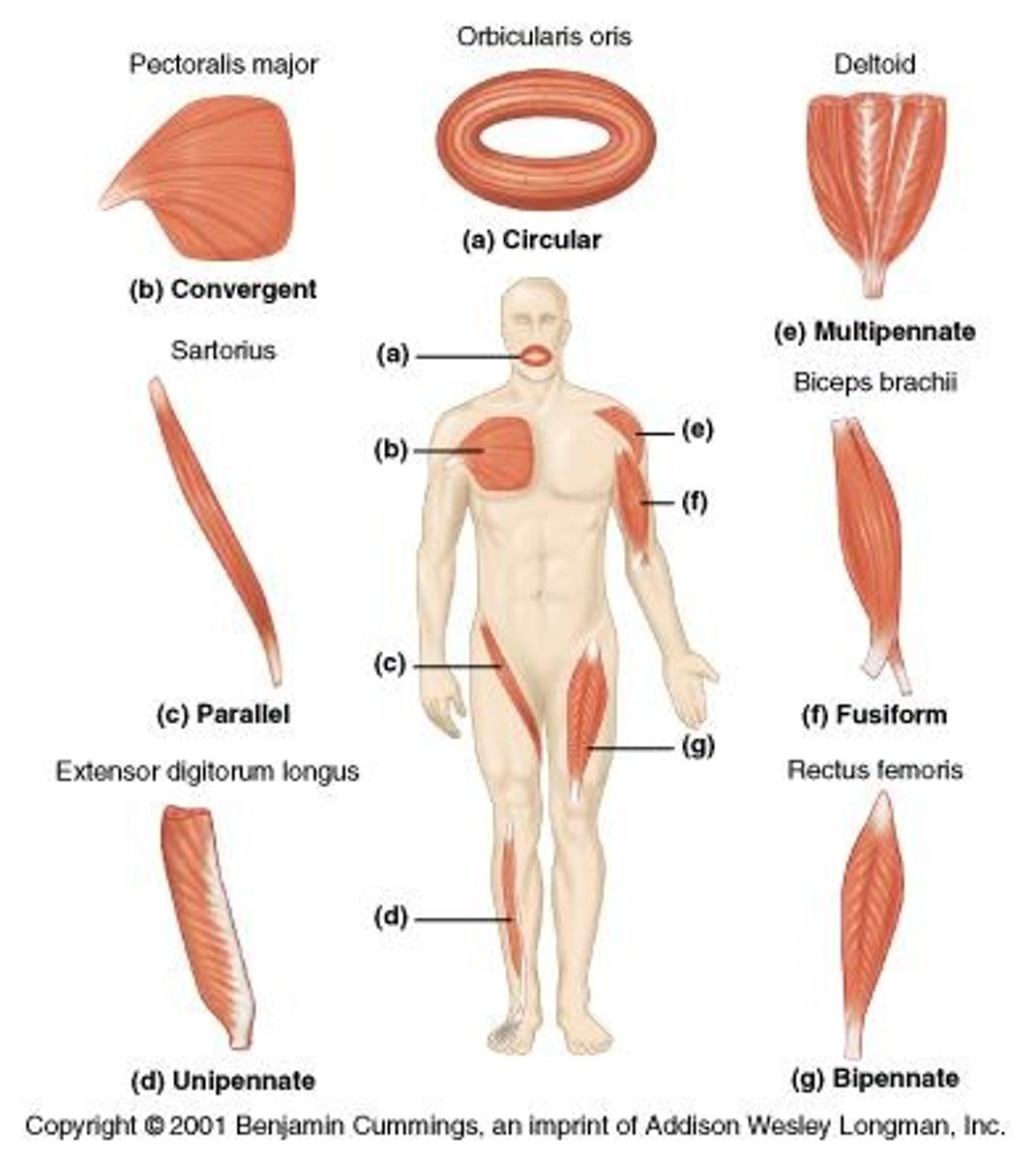
Describe the morphology of fusiform muscles.
Fusiform muscles have fibers that run parallel to one another towards a central tendon.
What characterizes pennate muscles?
Pennate muscles have fibers that run obliquely towards a central tendon, allowing for greater muscle force due to more muscle fibers.

What are the three sub-divisions of pennate muscles?
Unipennate, bipennate, and multipennate.
What does Physiologic Cross-Sectional Area (PCSA) indicate?
PCSA reflects the amount of active proteins available to generate contractile force in a muscle.
How is PCSA determined for fusiform muscles?
By cutting through the muscle belly or dividing muscle volume by muscle length.
What is the relationship between muscle thickness and force production?
Thicker muscles produce greater forces than thinner muscles.
What are normal forces in muscle function?
Forces that are perpendicular to the joint's axis of rotation, producing torque and joint motion.
What are tangential forces in muscle function?
Forces that are parallel to the joint's axis of rotation, which do not produce torque or joint motion, but can cause joint distraction or compression.
What is the pennation angle?
The angle of orientation between muscle fibers and the central tendon, affecting force transmission.
How does a pennation angle of 30 degrees affect force transmission?
Approximately 86% of the force is transmitted to the long axis of the tendon.
What is the role of epimysium in muscle anatomy?
Epimysium is a tough structure that surrounds the muscle belly and separates it from other muscles.
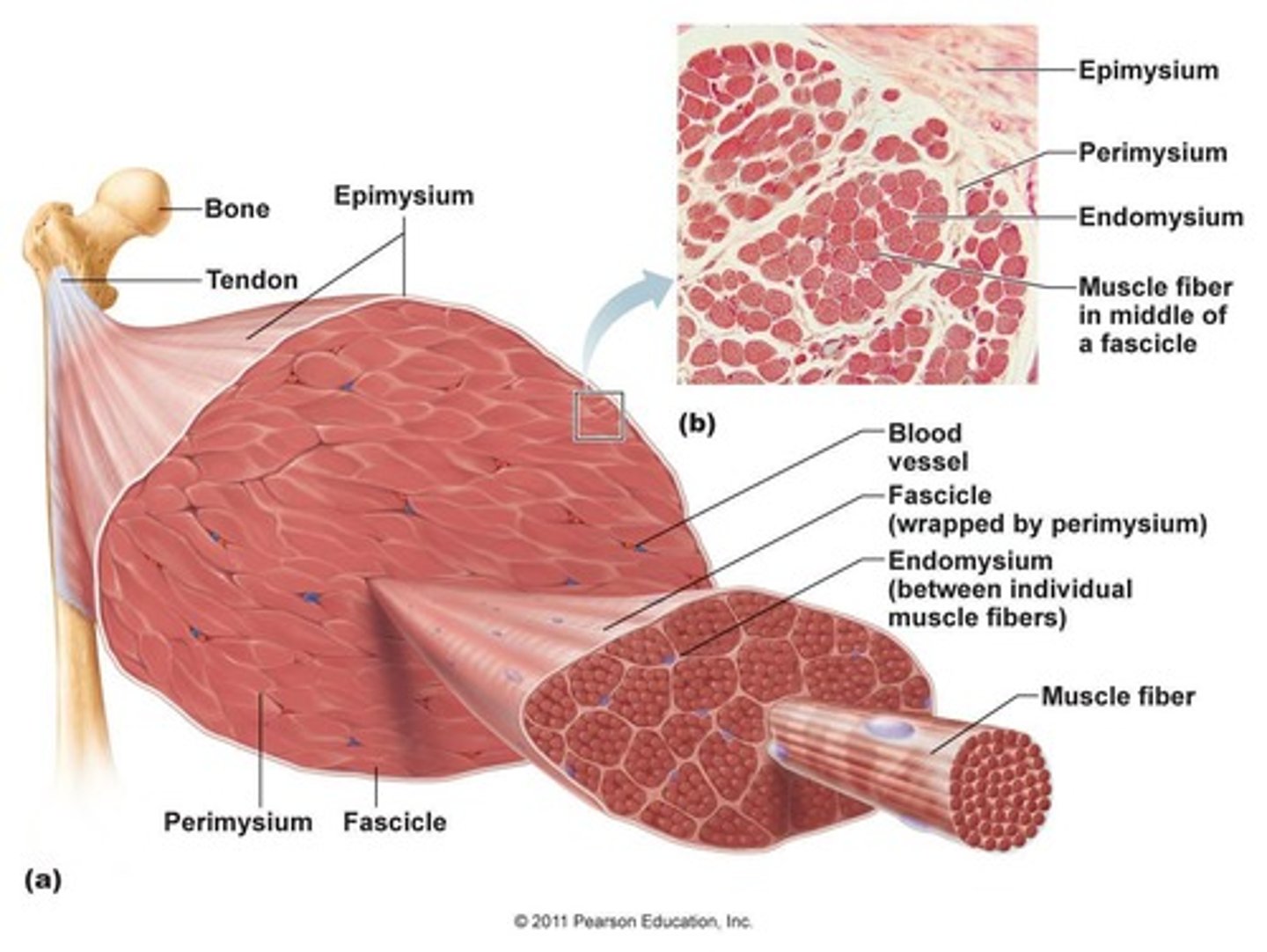
What does perimysium do in muscle structure?
Perimysium lies beneath the epimysium and divides muscles into fascicles, providing conduits for blood vessels and nerves.
What is the function of endomysium?
Endomysium surrounds individual muscle fibers and facilitates metabolic exchange between muscle fibers and capillaries.
What are myofibrils?
Tiny strands within muscle fibers that contain the contractile proteins of the muscle.
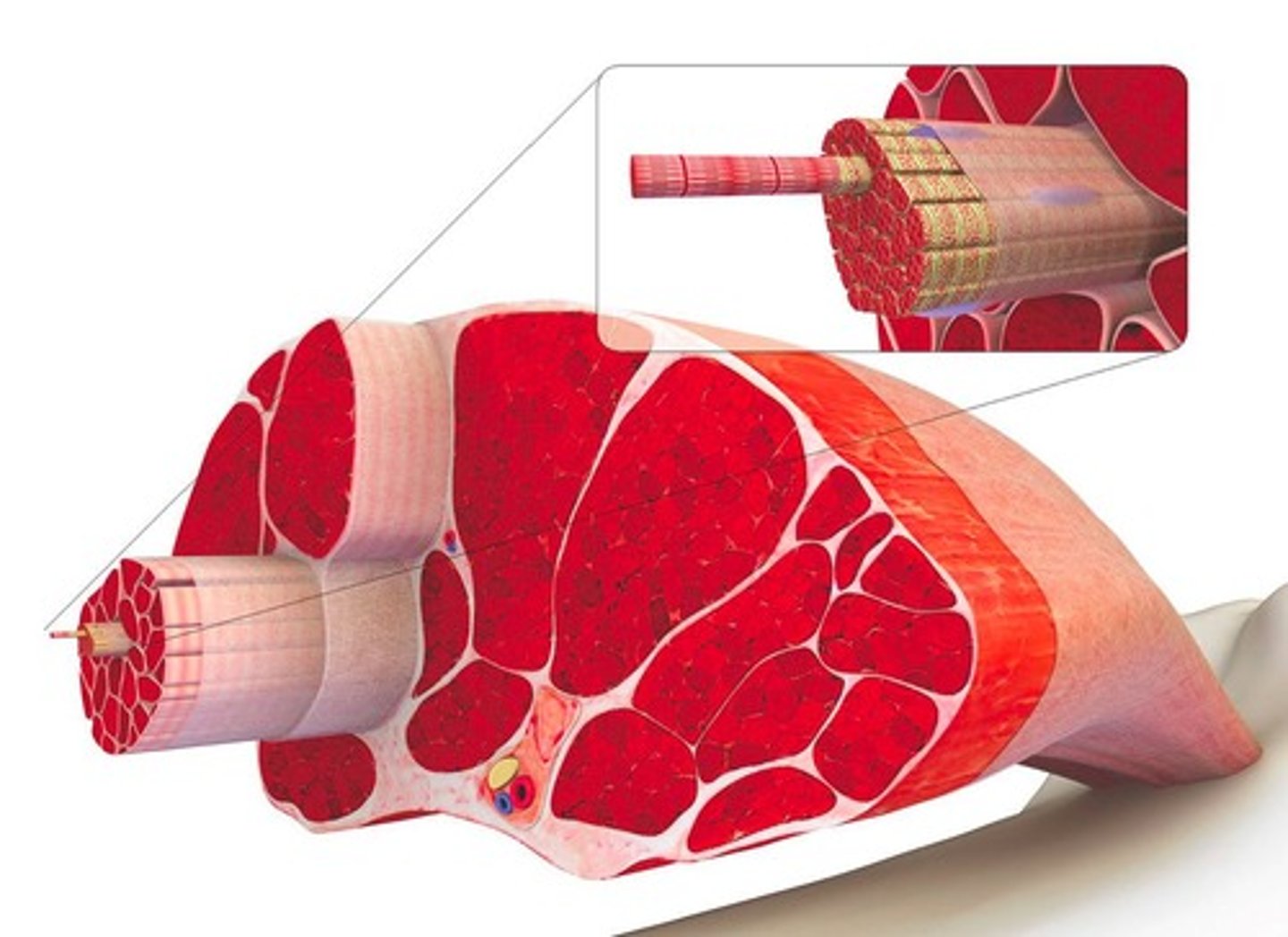
What are the two most important myofilaments in muscle contraction?
Actin and myosin.
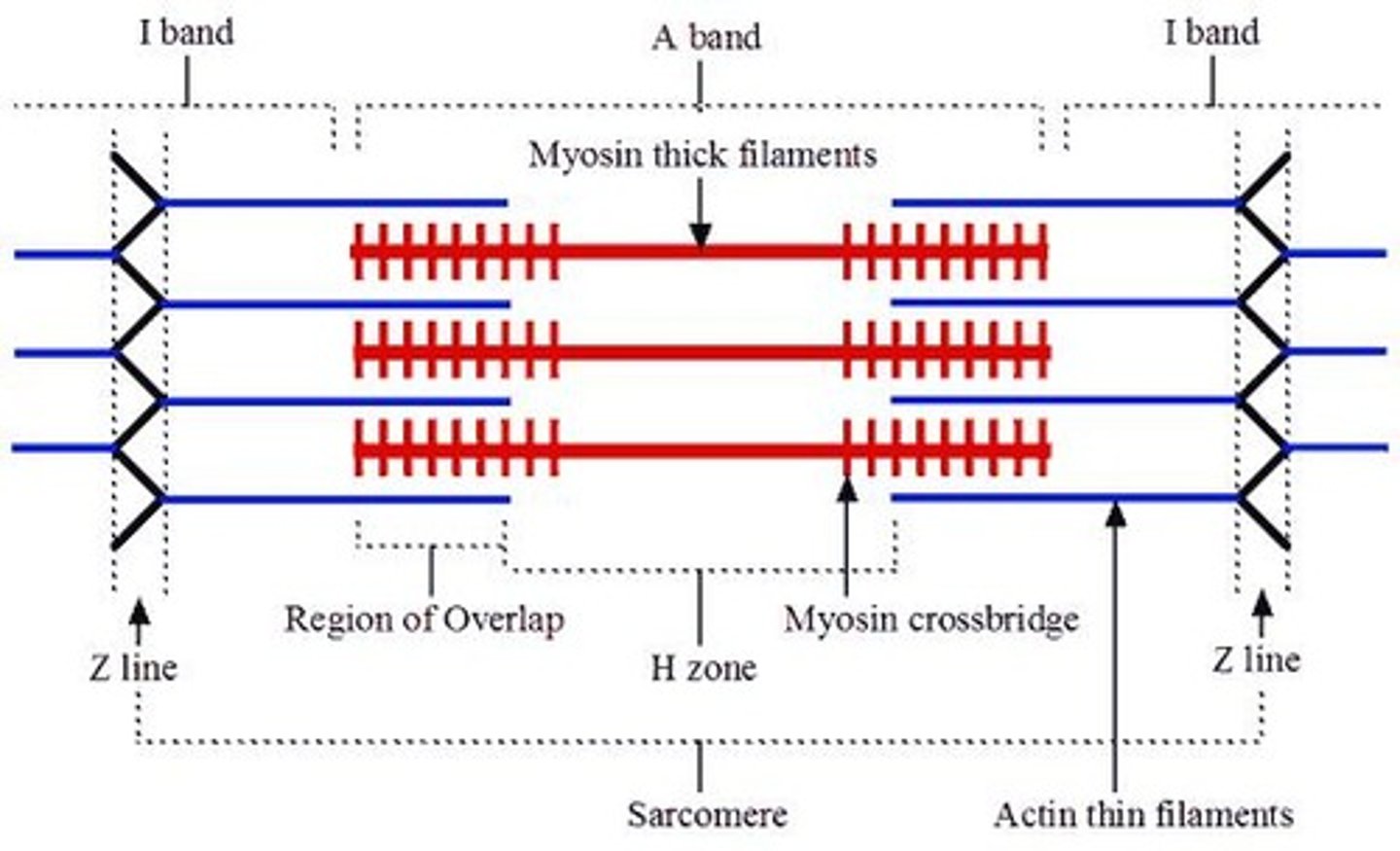
What is the sliding filament hypothesis?
It describes how myosin heads attach to actin filaments, forming cross bridges that allow actin to slide past myosin, shortening the sarcomere.
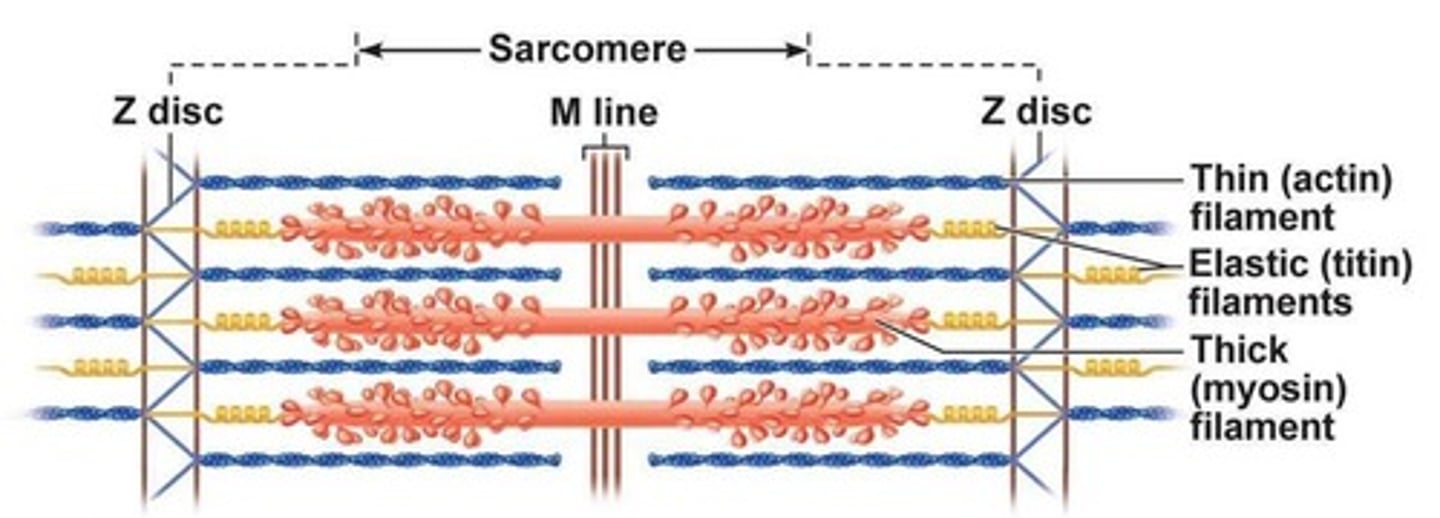
What does the length-tension curve represent?
It illustrates the relationship between muscle length and the force it can produce during contraction.
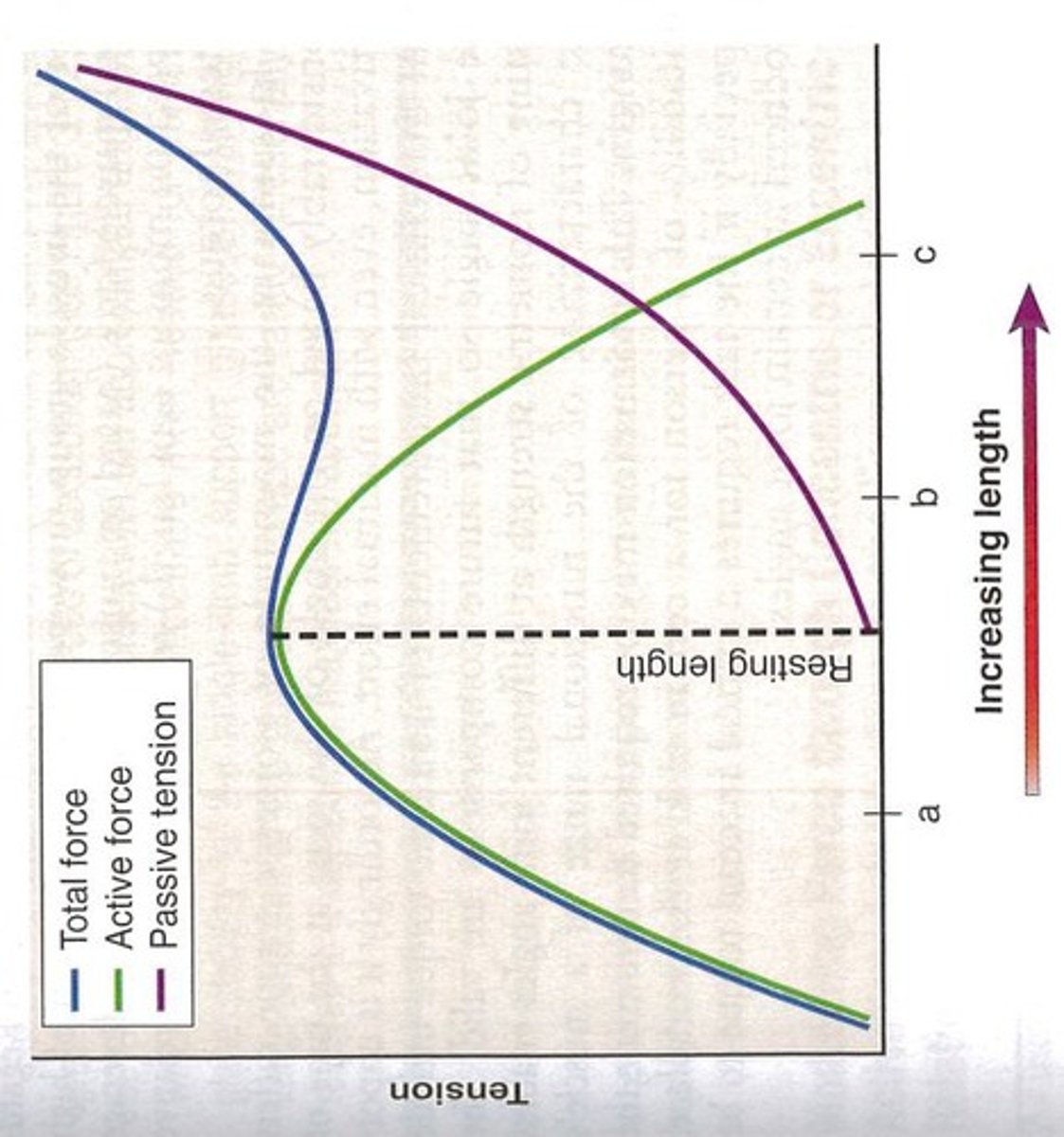
What happens during passive length-tension in muscles?
Stretching a muscle elongates both parallel and series elastic components, producing a spring-like resistance.
What is the Passive Length-Tension Curve?
It describes the elastic forces produced by non-contractile elements like extracellular connective tissue and tendons, which provide passive tension to muscles.
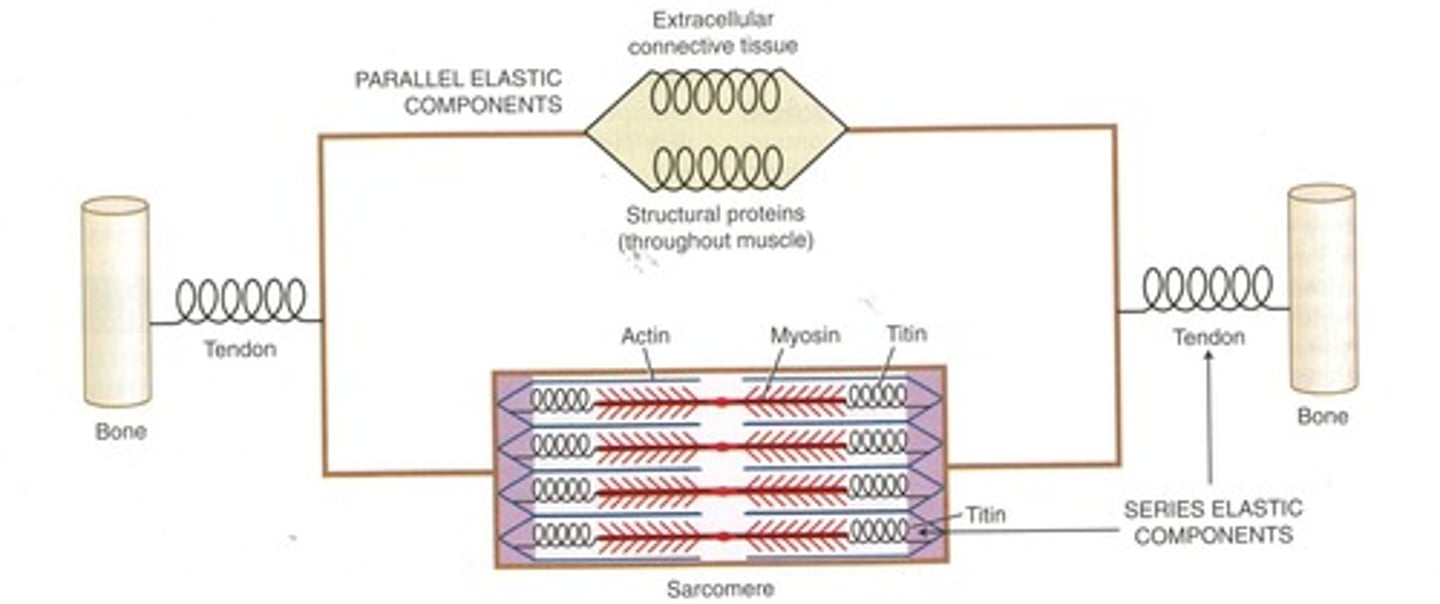
What role does Titin play in muscle tension?
Titin is the first protein to provide passive tension in muscles, followed by extracellular connective tissue and tendons.
What is the function of passive tension in muscles?
Passive tension helps stabilize joints against gravity and assists in injury prevention by dampening forces through the body.
What is Active Length-Tension Curve?
It refers to the active force produced by muscle fibers that are stimulated to contract by the nervous system.
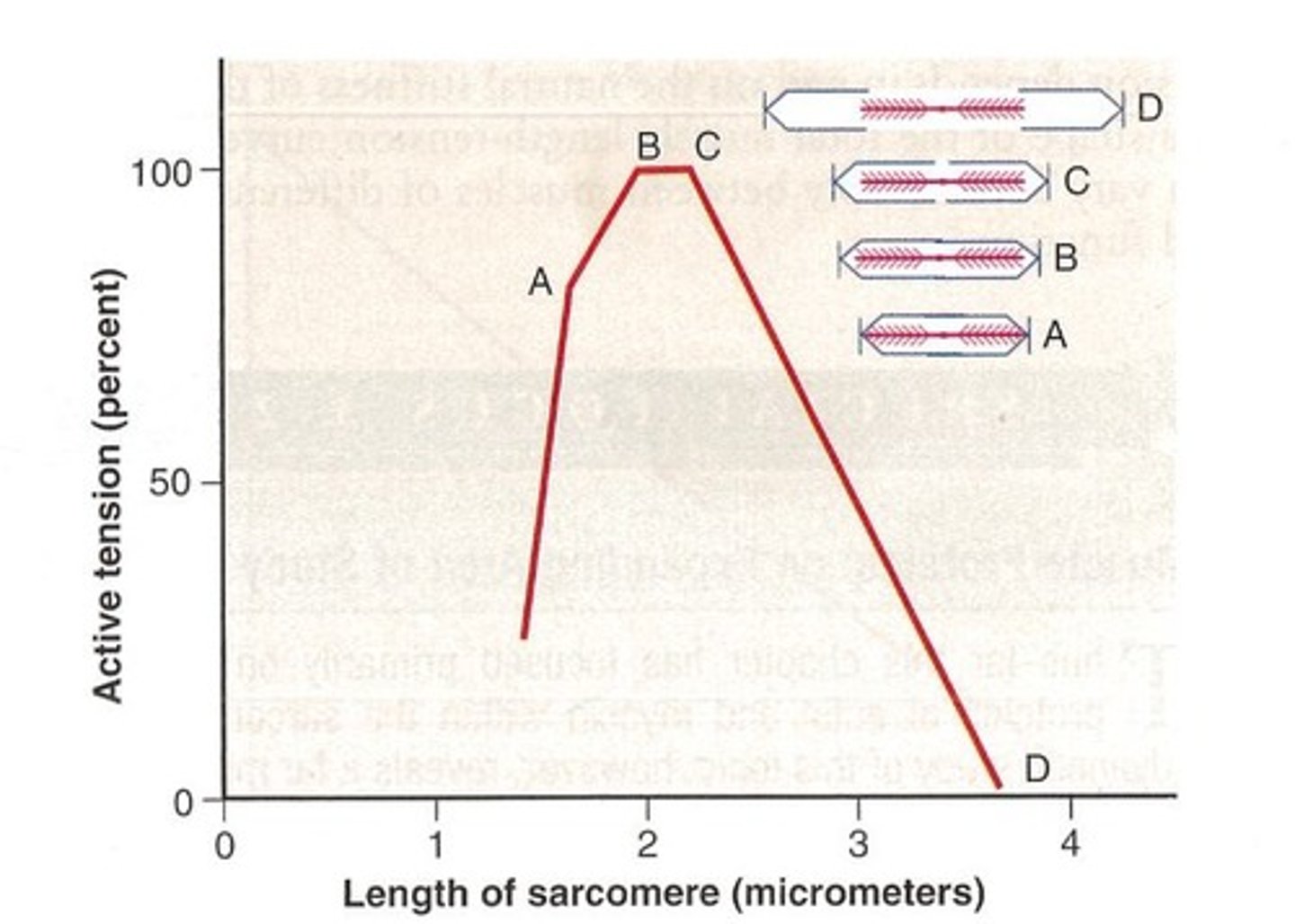
What is the Ideal Resting Length of a Muscle Fiber?
It is the length that allows for the greatest number of cross bridges to form, optimizing muscle contraction.
What is the relationship between optimal muscle length and resting length?
Optimal Length is approximately 1.2 times the Resting Length, allowing for maximal tension development.
What is Active Insufficiency?
It refers to a muscle's diminished ability to produce or maintain tension actively due to loss of its length-tension relationship, especially in two-joint muscles.
What is Passive Insufficiency?
It occurs when a muscle cannot lengthen sufficiently to allow full range of motion at one joint due to being stretched at another joint.

What is a Motor Unit?
A motor unit consists of a single alpha motor neuron and all the muscle fibers it innervates.
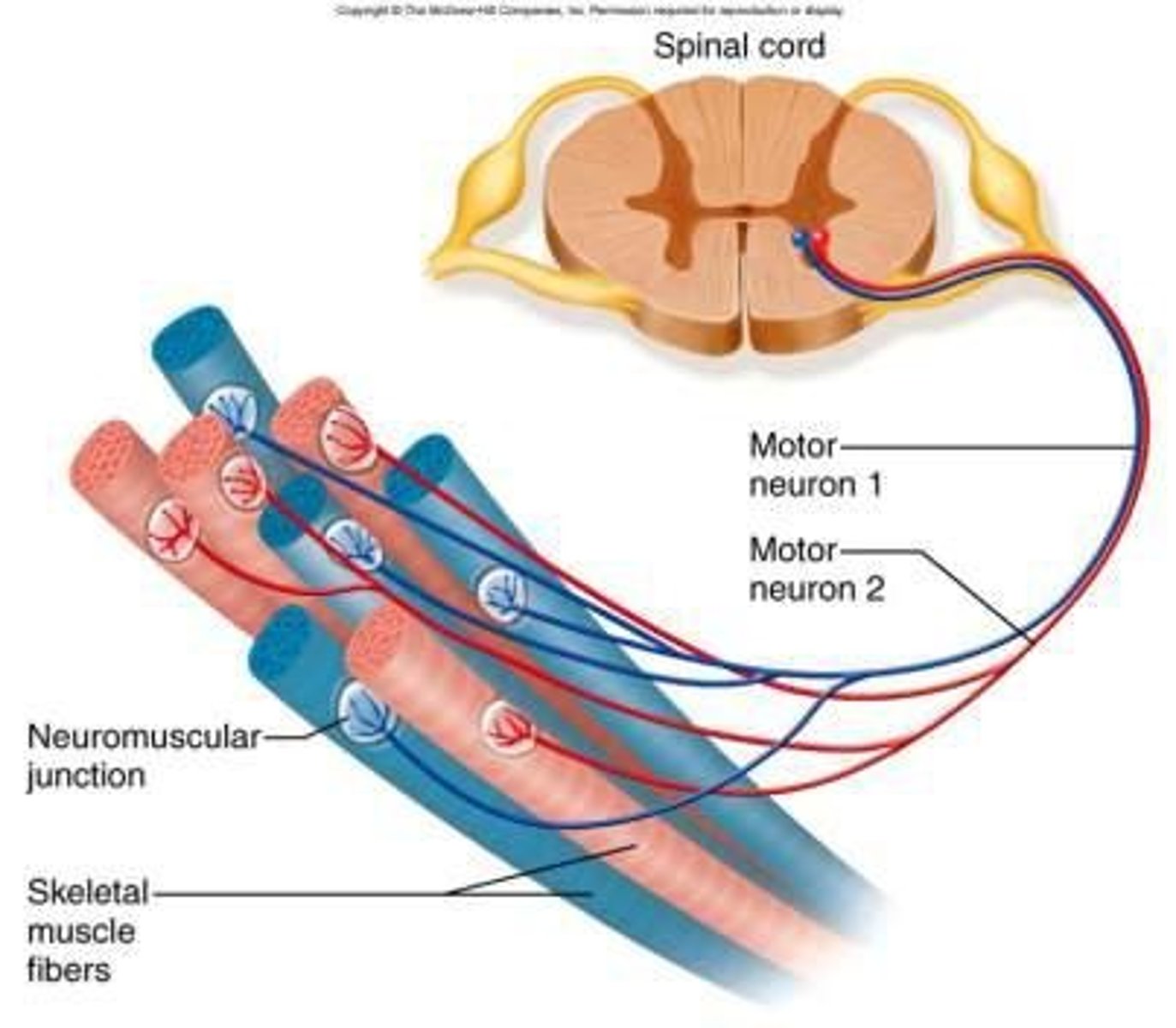
What is the Henneman Size Principle?
It states that smaller motor neurons are recruited before larger ones, allowing for smooth, controlled increments in force development.
What is an Isometric contraction?
It is when a muscle produces force without a significant change in length, providing stability to the body.
What occurs during a Concentric contraction?
The internal torque exceeds the external torque, allowing the muscle to shorten and bones to approximate.
What happens during an Eccentric contraction?
The external torque exceeds the internal torque, causing the muscle to elongate while still being activated by the nervous system.
How does load affect concentric and eccentric contractions?
In concentric contractions, increased load decreases contraction velocity; in eccentric contractions, increased load increases contraction velocity.
What is the Force-Velocity Curve?
It illustrates the relationship between muscle force output and the velocity of contraction or elongation, showing that maximal force is inversely proportional to contraction velocity.
What type of muscle contraction produces the greatest force?
Eccentric contractions produce the greatest amount of force coupled with the fastest velocity.
What is Positive Work in muscle contractions?
Positive work occurs when a muscle is concentrically contracting against a load.
What is Negative Work in muscle contractions?
Negative work occurs when a muscle is eccentrically contracting against a load.
What is the significance of cross bridges in muscle contraction?
Cross bridges are responsible for the attachment and re-attachment during muscle contraction, affecting force production.
What is the impact of muscle length on force production?
Muscle force production is highest isometrically and decreases with increased velocity during concentric contractions.
What is the role of passive tension in injury prevention?
Passive tension aids in dampening forces through the body, which helps prevent injuries.
How does muscle insufficiency affect performance?
Muscle insufficiency leads to less than ideal muscle length, affecting the ability to produce optimal contractions.
What is the relationship between muscle contraction types and joint angles?
The magnitude of isometric torque varies based on the joint angle at the time of muscle activation.
What are the characteristics of eccentric muscle contractions?
Eccentric contractions require greater force to detach cross bridges and are associated with lower EMG and O2 consumption compared to concentric contractions.
What are the two main types of muscle contractions?
Concentric and eccentric contractions.
What is the role of muscle in movement?
Muscle can act as an 'accelerator' and/or 'brake' during movement.
What are the three types of muscle fibers?
Fast Fatigue-Resistant (FR), Slow-Oxidative (SO), and Fast-Fatigable (FF) fibers.
What characterizes Slow-Oxidative (SO) fibers?
They are fatigue-resistant, have slower contractile characteristics, and utilize oxidative energy systems.
What are Fast-Fatigable (FF) fibers known for?
They are associated with larger motor neurons, have brief twitch responses, and are easily fatigable.
What does electromyography measure?
It records and interprets the electrical activity from activated skeletal muscle.
What causes muscle fatigue?
Reduced excitability at the neuromuscular junction, changes in excitation-contraction coupling, and reduced energy sources.
What is neural plasticity in the context of strength training?
The ability of the neuromuscular system to adapt to different external demands or stimuli.
How is strength quantified in muscle training?
Through a one-repetition max (1RM), which is the maximum load a muscle can move during a full range of motion.
What is hypertrophy?
The adaptation to increased force demands, resulting in an increase in muscle cross-sectional area.
What is delayed onset muscle soreness (DOMS)?
Soreness that occurs 24-72 hours after exercise, usually more severe after eccentric loading.
What happens to muscles with reduced use?
There is a loss of strength, particularly when muscles are maintained in a shortened position.
What is muscle atrophy?
The adaptation to decreased force demands, resulting in a decrease in muscle size and strength.
How does aging affect muscle function?
It is associated with reduced strength, power, and speed of muscle contraction, especially in lower extremities.
What is the impact of exercise intensity on strength gains?
High intensity exercises yield greater strength gains compared to low intensity exercises.
What is the significance of eccentric training?
Eccentric training is crucial for strength gains and is associated with greater muscle hypertrophy.
What are the effects of aging on muscle fiber types?
Type I fiber loss predominates, while endurance athletes may lose type I fibers and explosive athletes may lose type II fibers.
What is the relationship between muscle training and the nervous system?
Strength gains can result from adaptations within the nervous system, including increased motor neuron excitability.
What is the role of connective tissue in muscle hypertrophy?
Increases in connective tissue contribute to muscle strength and size during hypertrophy.
What is the primary effect of low-intensity exercises?
They allow for gains in endurance but yield lesser strength gains compared to high-intensity programs.
What is the difference between concentric and eccentric contractions?
Concentric contractions involve muscle shortening, while eccentric contractions involve muscle lengthening.
What is the significance of muscle fiber ratios?
Alterations in fiber type ratios can affect performance and adaptation to training.
What is the relationship between muscle fatigue and recovery?
Recovery times vary based on the intensity and duration of the activity, with high intensity requiring shorter recovery.
What is the role of surface electrodes in electromyography?
Surface electrodes are used to record electrical activity from superficial muscles.
What factors influence muscle strength gains?
Type and intensity of exercise, neural adaptations, and muscle fiber type composition.